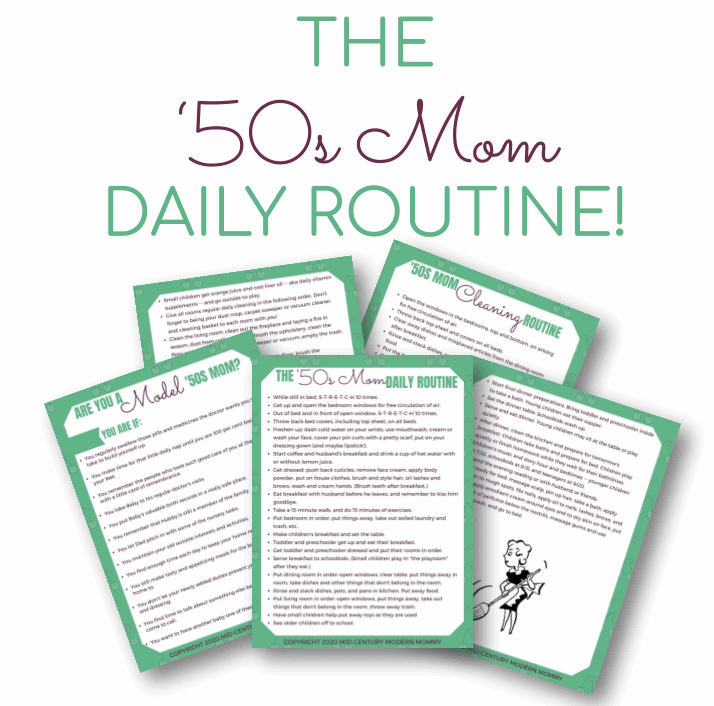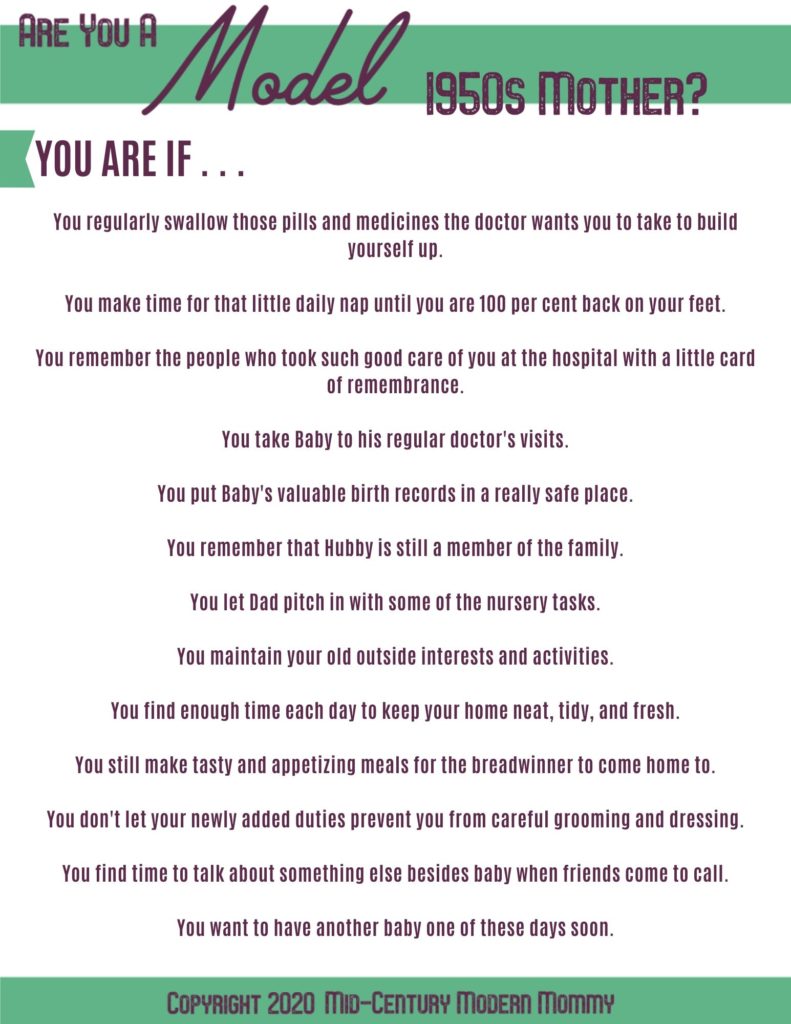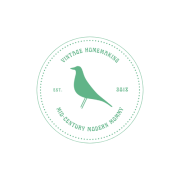If you have ever wondered exactly who decided on the ideal 1950s mom — look no further! There’s a list for that! Back in 2012, Jen But Never Jenn published a list from 1959 that outlined the model mid-century mom. I love working toward fabulously high standards, so I turned it into a project! So, are you a model 1950s mother?

Get Our Mid-Century Mom Daily Routine FREE!
- Are You A Model 1950s Mother?
- You regularly swallow those pills and medicines the doctor wants you to take to build yourself up.
- You make time for that little daily nap until you are 100 per cent back on your feet.
- You remember the people who took such good care of you at the hospital with a little card of remembrance.
- You take Baby to his regular doctor's visits.
- You put Baby's valuable birth records in a really safe place.
- You remember that Hubby is still a member of the family.
- You let Dad pitch in with some of the nursery tasks.
- You maintain your old outside interests and activities.
- You find enough time each day to keep your home neat, tidy, and fresh.
- You still make tasty and appetizing meals for the breadwinner to come home to.
- You don't let your newly added duties prevent you from careful grooming and dressing.
- You find time to talk about something besides baby when friends come to call.
- You want to have another baby one of these days soon.
- The Model 1950s Mother Every Day
This post contains affiliate links. If you click a link and make a purchase, I may receive, at no additional cost to you, a small commission. Find out more on my Disclosures page, and thank you so much for your support!
Are You A Model 1950s Mother?

You regularly swallow those pills and medicines the doctor wants you to take to build yourself up.
This amuses me no end. Where’s my mid-century Valium prescription, people? (Kidding.) Actually, this is really just reminding mothers about basic self-care. It’s the put-your-own-oxygen-mask-on-first idea in action. Your baby is utterly dependent on you; you can’t meet his needs unless you are healthy and in good condition. (Like a racehorse — or a prize milk cow!)
Seriously, though, this is about doing the most basic things for yourself: seeing your doctor regularly, and replenishing your health. Eat a healthy diet, especially if you’re breastfeeding. Get your vitamins and minerals. Get physical checkups. And definitely talk to your doctor about any “baby blues.” Most of the time, you won’t even need medication for it, but if you do, listen to your doctor’s advice!
You make time for that little daily nap until you are 100 per cent back on your feet.
This is another of those self-care items on the list. When you are getting up with your baby for late-night feedings — and you will be until at least 8 weeks! — you need to make up that missing sleep another way. Try to get a short nap every afternoon. Even just a half-hour nap will help.
Also, try to get some exercise every day. Sleep and exercise both help you cope with postpartum emotions. They also help with depression and anxiety. If you get a nap, exercise a little each day, and eat a healthy diet, you will be well on your way to avoiding most postpartum health issues. (Caveat: I am not a doctor! Talk to your doctor! A lot! A model 1950s mother always consults her doctor.)
You remember the people who took such good care of you at the hospital with a little card of remembrance.
This one is all about etiquette and acting like a classy dame. It’s a bread-and-butter letter, just as if you had been a guest at the hospital. Being gracious and remembering the little things is what vintage etiquette is all about. Writing thank-you notes and birth announcements was just part of that.
On a similar note, Lily Wallace’s New American Etiquette (affiliate link) instructs parents that their first duty in teaching their offspring polite manners is to send out birth announcements. The behavior of the parents is the most important way of teaching a child etiquette and social behaviors. And therefore, the parents must begin as they mean to go on.
You take Baby to his regular doctor’s visits.
My vintage parenting books harp on this a lot. Apparently, it was quite common not to take the baby to the doctor unless he was sick. But, the baby’s health is as important as yours. See Baby’s pediatrician regularly and on schedule. I very seriously recommend that you follow your pediatrician’s advice! (If you can find one who recommends sleep training and schedules, even better!)
Middle-class mothers conscientiously took their children to the doctor, read books by experts on infant health and development, and were scrupulous about hygiene. Many of them could remember their own childhoods–when babies and children died too often and too young. They were the survivors, and they wanted their own children to survive, too. This is not the place to debate vaccination, but a model 1950s mother WOULD vaccinate her children, and treat them with antibiotics and other drugs as well, following her pediatrician’s recommendations to the letter and without question.
You put Baby’s valuable birth records in a really safe place.
This really has two parts. First, it is implying that you are organized enough to keep paperwork properly. I mean, you ARE storing the birth certificate and hospital birth record with the social security cards, passports, and marriage license in a safe-deposit box in your bank, right? (At least I keep them in a safe . . .)
Second, this is about keeping a record of Baby. I have several great record books, sections, and pages from my vintage baby books. They tracked feeding, diapers, sleep, schedule, and development, as well as milestones and memories. It is a great idea to keep a good record of all your babies, especially a logbook that includes baby’s special moments.
You remember that Hubby is still a member of the family.
This advice is probably controversial; ladies, put your husbands first, before your children. That doesn’t mean that the parents don’t sacrifice for their children (together!), but it does mean that your marriage is the reason for your family — not the other way around. Your children need you to stay married, but they also need to see that your marriage is loving and supportive. Then it becomes an anchor — a safe haven that allows them to grow up and explore life securely.
It also is their first lesson in what it means to be an adult. Marriage takes work. Being an adult takes work. And Hubby is working to be a father. Don’t become his mother, or treat him like a child. And don’t nag. Be loving and accepting of his shortcomings. It is very likely that he will have NO ONE but you to encourage him, support him, listen to him, and make him feel loved. That is powerful medicine for your marriage.
You let Dad pitch in with some of the nursery tasks.
It’s a lot more common now for fathers to pitch in with baby care, even changing diapers. But often fathers are treated like they will do something stupid or dangerous with the baby. Mothers and fathers treat babies differently because men and women are different. Dad may not do things the way you do. His way of doing things may drive you UP THE WALL. But as long as Dad isn’t putting whiskey in Baby’s bottle or shaking him, you should bite your tongue.
This really goes back to the fact that you can’t force anyone else to do things for your baby exactly as you do. You couldn’t micromanage your daycare provider. You also shouldn’t nag or nitpick at Dad. Nagging is honestly the number one destroyer of homes and marriages. Who wants to live with a shrew? (Yes, men can be shrewish, too.) Let him do things his way, and go take a long, hot bath so you don’t have to watch and worry.
You maintain your old outside interests and activities.
It matters who you were before Baby. YOU ARE STILL A PERSON, SO DO YO’ THANG, MAMA! Don’t submerge yourself in your children’s lives. Don’t make them more important than you. This is the root cause of so many young couples turning away from child-rearing toward being child-free. They saw their mothers adopt Dr. Sears’ parenting principles, neglect themselves to focus on their children, become depressed and disillusioned, and get divorced to “find” themselves once more. That same neglect of personal care, personal interests, and personality leads to the hot mess problem of modern moms. If you don’t take care of yourself, including continuing to engage in things that “spark joy” for you, you run the risk of depression and eventual divorce.
On the other hand, you also need to be able to say “no” to things that are not really sparking joy. Don’t clutter your life with activities to avoid your feelings. Don’t assume that going shopping at Target will fill up a hole in your heart that is caused by a lack of self-care. Your outside interests and activities should be real, valuable, and important to your personal fulfillment, but not a way of avoiding unpleasant realities OR a quick hit of endorphins from finding a deal on stuff you don’t need! You are far more likely to find joy from Konmari-ing your house.
You find enough time each day to keep your home neat, tidy, and fresh.
A model 1950s mother is still a housewife. She finds a way to keep up with her housekeeping. This sentence beautifully sums up the three important aspects of housekeeping: neat (orderly and organized, not cluttered), tidy (clean, no dust or filth), and fresh (aired out, pretty, and healthy). At least focus on the basics: make beds, put things away, clear surfaces, clean floors, wash up after every meal, and tackle the bathroom every day.
The only way to get this done is to make a schedule that includes housekeeping. Also, you need a cleaning plan that covers laundry, daily and weekly cleaning, and other weekly chores. Then, you probably need a schedule for your baby and your other children, so you can fit everything in. Start now! If your children grow up in a home that is clean and well-kept, it is a lot easier to teach them to be orderly and care for their stuff instead of destroying it.
You still make tasty and appetizing meals for the breadwinner to come home to.
The man bringing home the bacon needed his bacon to be hot and savory, on the table, with a smiling wife serving it alongside some fresh-baked bread! Seriously, though, plan on having dinner as a family every night. Hopefully, you were already doing this — eating together promotes bonding and strengthens relationships, so hopefully, you’ve been making time for dinner with your man every night since you married! But now that you have children, it is super important to have family dinners, without screens, every night.
I recommend planning all your meals for at least a week: breakfasts, lunches, and dinners. Otherwise, you find yourself having to come up with breakfast when you are exhausted, or unable to make lunch because the baby was crying at you in the store and you forgot half of the things you were shopping for. Planning meals helps you stay in budget and eat healthier food. Also, planning all the meals at once helps you make sure that everyone is getting a good balance of nutrients.
You don’t let your newly added duties prevent you from careful grooming and dressing.
This is the quintessential model 1950s mother advice, right here. Not just cute clothes, but time for daily and weekly beauty routines. Gorgeous hostess gowns or brunch coats to wear in the evenings at home, and cute house dresses (affiliate link) and aprons to wear while working. Dress for dinner, fix your hair, and meet your husband at the door looking like something he wants to come home to! It goes a long way towards lifting your own spirits and avoiding the hot mess syndrome when you get up half an hour before anyone else to get dressed and fix your hair and face. A good beauty routine is an important part of self-care, just like hygiene.
You find time to talk about something besides baby when friends come to call.
This is partly etiquette and partly mental health. It is always good to listen to your friends and have real conversations with them when they come to call. One of the best things I can do for my husband, children, and friends is really listening to them–asking them what they think, listening with my whole body, then reflecting it back to them so they feel understood. Good listening is a powerful tool.
Of course, it is also good to have your outside interests, which you hopefully share with your friends, to talk about together. Even if all you can do is keep abreast of current events, try to have some topic of common interest to lead into a conversation. This is also good to have at dinner, and in the evenings when you have couch time with your husband.
You want to have another baby one of these days soon.
So, another controversial piece of advice: have a lot of kids. Not just two or three. Like five. It’s good for you, good for your husband, good for your kids. Baby fever is real because it benefits everybody. When you are a model 1950s mother, you have the systems in place to raise polite, wholesome, healthy children with good character and sound minds. They grow up to be good citizens and hard workers. And the world can always use more of those.

The Model 1950s Mother Every Day
This looks like a lot. It covers everything from your behavior to your marriage to your housekeeping. But it also shows all the different areas to address when you make your own 1950s Mom Daily Routine. Each one of these topics comes with its own set of lists and ideas and advice. Being a mom is a busy job! But, at least it is something to work toward, and a roadmap out of hot mess syndrome!



